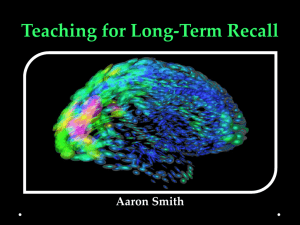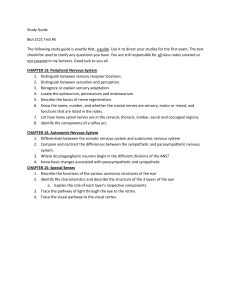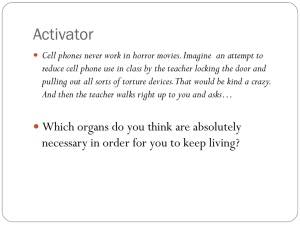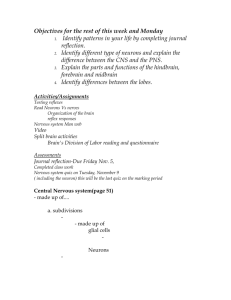The Nervous System
advertisement
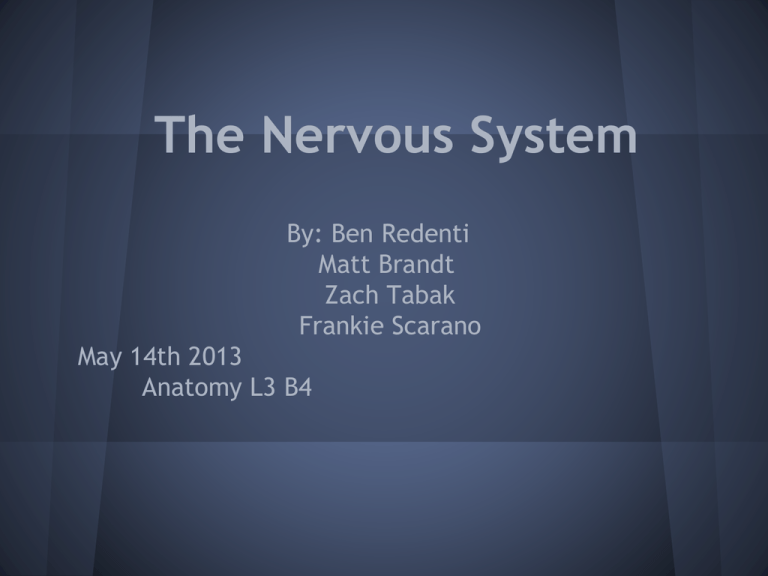
The Nervous System By: Ben Redenti Matt Brandt Zach Tabak Frankie Scarano May 14th 2013 Anatomy L3 B4 What is the Nervous System? • • • • System body that coordinates the voluntary and involuntary actions of the animal and transmits signals between different parts of its body. The nervous system is divided into two major categories the Central Nervous System (CNS) and the Peripheral Nervous System (PNS). The CNS includes the brain and spinal cord. (Located along the vertical midline of the body) The PNS is comprised of all the nerves that lie outside of, or peripheral to the CNS. Brain • • • • An organ of soft nervous tissue contained in the skull of vertebrates, functioning as the coordinating center of sensation and intellect. All neurons, however, relay information to each other through a complex electrochemical process, making connections that affect the way we think, learn, move, and behave. Intelligence, learning, and memory. http://kidshealth.org/parent/interactive/brain_it.html The Central Nervous System (CNS) • • • The brain is the control center of the body. It consists of three main components: o the forebrain o the brainstem o the hindbrain Forebrain: responsible for a variety of functions including receiving and processing sensory information, thinking, perceiving, producing and understanding language, and controlling motor function. The forebrain contains structures such as the thalamus and hypothalamus It also contains the largest part of the brain, the cerebrum. CNS (cont.) • • Midbrain: the portion of the brain stem that connects the hindbrain and the forebrain o The midbrain and the hindbrain together make up the brainstem. Hindbrain: extends from the spinal cord and contains structures such as the pons and cerebellum. The hindbrain also contains the medulla oblongata The Senses • • • None of your senses would be useful without the processing that occurs in the brain. Sight: Sight probably tells us more about the world than any other sense. Light entering the eye forms an upsidedown image on the retina. The retina transforms the light into nerve signals for the brain. The brain then turns the image right-side up and tells us what we are seeing. Hearing: Every sound we hear is the result of sound waves entering our ears and causing our eardrums to vibrate. These vibrations are then transferred along the tiny bones of the middle ear and converted into nerve signals. The Senses (cont.) • • Taste: The tongue contains taste buds that react to chemicals in foods. Taste buds react to sweet, sour, salty, and bitter. Messages are sent from the taste buds to the areas in the cortex responsible for processing taste. Smell: Olfactory cells in the mucous membranes lining each nostril react to chemicals we breathe in and send messages along specific nerves to the brain— which, according to experts, can distinguish between more than 10,000 different smells. The Senses (cont.) • • Touch: The skin contains more than 4 million sensory receptors, mostly concentrated in the fingers, tongue, and lips, that gather information related to touch, pressure, temperature, and pain and send it to the brain for processing and reaction. Contrary to what many people think, humans do not have only five senses. We humans have over a dozen senses including sense of hunger, thirst, fullness, and pain. Peripheral Nervous System (PNS) • The main function of the PNS is to connect the central nervous system (CNS) to the limbs and organs. • The PNS is not protected by the bone of spine and skull, or by the blood–brain barrier, leaving it exposed to toxins and mechanical injuries. • Divided into two smaller systems: o Somatic System: Control system, functions below the level of consciousness o Autonomic System: Voluntary control of body movements Somatic System • • Controls all voluntary muscle systems in the body. (exception reflex arc) Sending nerve signals through a basic route: Motor neurons Corticospinal tract via axons Stimuli conveyed from motor neurons to spinal cord through ventral horn. Received by sensory receptors of motor neurons of the brain stem. Act. released from axon terminal which relays stimuli Act. released from the axon terminal knobs of motor neurons and received by postsynaptic receptors This relays stimuli to contract muscle fibers. Somatic (cnt.) • • There are forty three segments of nerves in our body and with each segment there is a pair of sensory and motor nerves. In the body, thirty one segments of nerves are in the spinal cord and twelve are in the brain stem. 3 parts of Somatic System: a. b. c. Spinal Nerves: They are peripheral nerves that carry sensory information into the spinal cord and motor commands. Cranial Nerves: They are the nerve fibers which carry information into and out of the brain stem. They include smell, vision, eye, eye muscles, mouth, vision,. Taste, ear, neck, shoulders and tongue. Association Nerves: These nerves integrate sensory input and motor output numbering thousands. Autonomic System • • • • Located in medulla oblongata (lower brainstem). Controls all visceral functions: • • • • • Heart Rate Digestion Respiratory Rate Perspiration Sexual Arousal Most are involuntary functions, though some may be acted upon through some level of consciousness. An example would be sexual arousal as voluntary, and digestion as involuntary. Again split into two systems: Sympathetic System Parasympathetic System Sympathetic vs. Parasympathetic • Sympathetic: o Responsible for up- and down-regulating many homeostatic mechanisms in living organisms. o Most notably for the sympatho-adrenal response of the body, or the fight-or-flight response. • Parasympathetic: o Generally works to promote maintenance of the body at rest. o It occurs unconsciously and is responsible for the regulation of the internal organs and glands. Neurotransmitters • • Biochemicals that carry out synaptic transmission Synaptic Transmission: messages being transferred across synaptic clefts (gaps between neurons) • There are about 50 known types of neurotransmitters Types of Neurotransmitters •• • • • Acetylcholine Monoamines Amino Acids Neuropeptides Acetylcholine (ACh) • • • • Stimulates muscle contraction Diffuses across synaptic cleft Binds to specific protein molecules in the muscle fiber This begins a chain reaction that contracts the muscle, as long as ACh is released Monoamines • • • • Formed from modified amino acids Thought to trigger emotional feelings Dopamine: Creates a sense of pleasure Serotonin: Causes sleepiness; inhibitory Amino Acids • • • The "building blocks" of proteins Glutamic Acid: aids in learning and memorization Gamma-aminobutyric Acid (GABA): relieves anxiety Neuropeptides • • • Short chains of amino acids Substance P: pain perception Endorphins: reduces pain; antagonist of SP • In a healthy nervous system, there is an endless cycle of neurotransmitters o Some neurotransmitters are decomposed and rebuilt (Acetylcholine) o Others are transported back to the synaptic knob that released them or into nearby neurons Nervous System Diseases • Alzheimer's Disease • Cerebral Palsy • Multiple Sclerosis • Parkinson's Disease Alzheimer's Disease: • • • • • Most common form of dementia, accounting for 50-80% of all cases Greatest risk factor is increasing age; 95% of sufferers are 65 y/o + Caused from massive degeneration of neurons and disruption of neurotransmission Symptoms: Progressive loss of memory and thinking ability, mood swings, personality changes, etc. Cholinesterase inhibitors & Memantine are the only two drugs approved to help in the Cerebral Palsy • • • • Disorder of muscle movement, tone, and posture Caused from abnormalities prior to, during, or up to two years after birth Symptoms: Spastic paralysis, fixed abnormalities of limbs, deficiencies in posture, balance, intelligence, and speech, etc. Treatments include a variety of specialists to help the sufferer adapt to life with CP Multiple Sclerosis • • • • • Autoimmune disease (Body attacks itself) Can affect people of any age; Most common symptoms reported ages 20-40; Women are twice as likely to be affected by MS Immune system attacks the neurons, gradually disintegrating or causes swelling of the myelin sheath around the axons -> Inhibits/slows neurotransmission within body Symptoms: Poor balance, vision, motor skills. Inability to control muscle movements, loss of strength, fatigue, etc. Immunosuppressive and Anti-inflammatory drugs can help with treatment Multiple Sclerosis (cont.) Parkinson's Disease • • • • Progressive disorder that affects movement Developed ages 50-65; Men are 1.5 times more likely to be affected; Genetic predisposition makes developing Parkinson's twice as likely Neurons in the substantia nigra become impaired or damaged -> cannot produce dopamine (neurochemical associated with movement) -> neurotransmission becomes harder between muscle and brain Early Symptoms: Slight tremor in one hand, little or no facial expressions, slight limp, etc. Progressive Symptoms: Slower movements, loss of fine motor control, tremors in one/both hands, slurred/impaired speech, stiffness in muscles Parkinson's Disease (cont.) Drug Treatments: Levodopa, MOA-B Inhibitors Work Cited • • • • • • • Shier, D., Butler, J., & Lewis, R. (2009). Hole's Essentials of Human Anatomy & Physiology (Tenth Edition ed.). New York: McGraw-Hill Higher Education. A, s., SS, K., ME, C., & J., S. (n.d.). Neurobiology of substance P and the NK1 re... [J Clin Psychiatry. 2002] - PubMed - NCBI. National Center for Biotechnology Information. Retrieved May 8, 2013, from http://www.ncbi.nlm.nih.gov/pubmed/12562137 "Left Brain/Right Brain | Scholastic.com." Scholastic, Helping Children Around the World to Read and Learn | Scholastic.com. N.p., n.d. Web. 10 May 2013. <http://www.scholastic.com/teachers/article/leftbrainright-brain>. "Nervous System." Dictionary.com. Dictionary.com, n.d. Web. 13 May 2013. "KidsHealth." Brain and Nervous System. N.p., n.d. Web. 13 May 2013. "Central Nervous System." About.com Biology. N.p., n.d. Web. 13 May 2013. "Brain Structures and Their Functions." Brain Structures and Their Work Cited (cont.) Alzheimer's Disease & Dementia | Alzheimer's Association. (n.d.). Alzheimer's Disease and Dementia | Alzheimer's Association. Retrieved May 14, 2013, http://www.alz.org/alzheimers_disease_what_is_alzheimers.asp Alzheimer's disease - National Library of Medicine - PubMed Health. (n.d.). National Center for Biotechnology Information. Retrieved May 14, 2013, http://www.ncbi.nlm.nih.gov/pubmedhealth/PMH0001767/#adam_0007 60 Alzheimer's: the chemistry behind the disease. (n.d.). Royal Society of Chemistry | Advancing the Chemical Sciences. Retrieved May 14, 2013, http://www.rsc.org/Publishing/Journals/cb/Volume/2009/9/Alzheimers _facts.asp Cause of Cerebral Palsy | Brain Damage | Cerebralpalsy.Org. (n.d.). CerebralPalsy.Org | The ULTIMATE Resource EVERYTHING Cerebral Palsy. Retrieved May 14, 2013, http://www.cerebralpalsy.org/about-cerebralpalsy/cause/ Works Cited (cont.) Cerebral palsy - MayoClinic.com. (n.d.). Mayo Clinic. Retrieved May 14, 2013, from http://www.mayoclinic.com/health/cerebral-palsy/DS00302 Cerebral palsy - National Library of Medicine - PubMed Health. (n.d.). National Center for Biotechnology Information. Retrieved May 14, 2013, from http://www.ncbi.nlm.nih.gov/pubmedhealth/PMH0001734/#adam_00071 6.disease.causes Diseases and Disorders of the Nervous System. (n.d.). IvyRose Holistic : Holistic Health, Alternative Medicine, Human Biology, Anatomy & Physiology and Chemistry Study Pages. Retrieved May 14, 2013, from http://www.ivy-rose.co.uk/HumanBody/Nerves/Nervous_Disorders.php Multiple sclerosis - MayoClinic.com. (n.d.). Mayo Clinic. Retrieved May 14, 2013, from http://www.mayoclinic.com/health/multiplesclerosis/DS00188 Multiple sclerosis — Diagnosis and treatment at Mayo Clinic. (n.d.). Mayo Clinic. Retrieved May 14, 2013, from http://www.mayoclinic.org/multiplesclerosis/?mc_id=comlinkpilot&placement=bottom Works Cited (cont.) Parkinson disease - Genetics Home Reference. (n.d.). Genetics Home Reference - Your guide to understanding genetic conditions. Retrieved May 14, 2013, from http://ghr.nlm.nih.gov/condition/parkinson-disease Parkinson's disease: Treatments and drugs/ - MayoClinic.com. (n.d.). Mayo Clinic. Retrieved May 14, 2013, from http://www.mayoclinic.com/health/parkinsonsdisease/DS00295/DSECTION=treatments-and-drugs/ Parkinson’s disease - National Library of Medicine - PubMed Health. (n.d.). National Center for Biotechnology Information. Retrieved May 14, 2013, from http://www.ncbi.nlm.nih.gov/pubmedhealth/PMH0001762/#adam_00075 5.disease.causes



